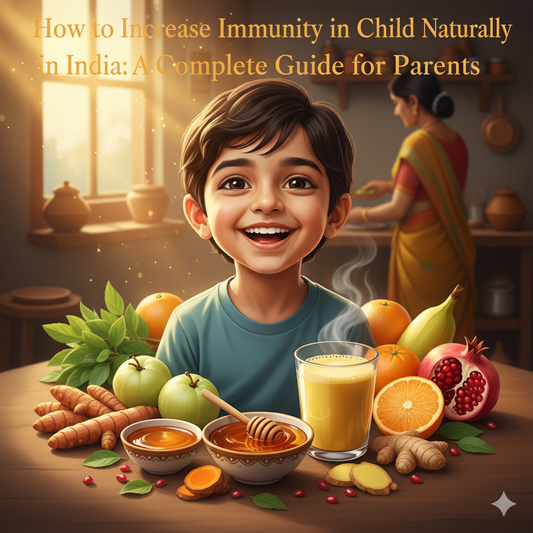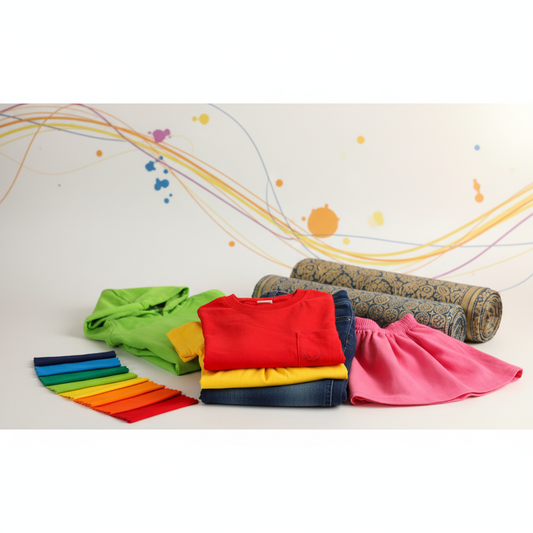
How to Remove Haldi Stains from Kids' Clothes: A Complete Guide
As a father of two energetic kids and a children's clothing manufacturer, I've seen my fair share of food disasters. If you're a parent, you know exactly what I'm talking about. Getting kids to eat without turning their clothes into an abstract art canvas is practically impossible. Those pristine white school shirts? They last exactly one dal-chawal lunch before sporting bright yellow haldi stains. And don't even get me started on the number of times my children have casually wiped their turmeric-covered hands or faces on my white trousers—turning a professional outfit into a tie-dye experiment in seconds!
We've all been there: that sinking feeling when you see that telltale yellow smear on your child's favorite dress or new shirt. Haldi stains seem to have a magnetic attraction to the most expensive or beloved pieces in your child's wardrobe.
About Us
Before we dive into the solutions, let me introduce ourselves. We're a kids' clothing manufacturer based in Tiruppur, Tamil Nadu—India's knitwear capital. With years of experience in producing quality children's garments, we understand fabrics inside and out. We serve both wholesale clients and retail customers through platforms like Myntra, Amazon, and our own website. Our hands-on experience with thousands of garments and feedback from countless parents has taught us not just how to make clothes, but how to care for them too. Today, I'm sharing our hard-earned wisdom about one of the most common challenges every Indian parent faces: removing haldi stains.
Why Are Haldi Stains So Stubborn? The Science Behind Turmeric
Understanding your enemy is half the battle won. Haldi (turmeric) contains a powerful compound called curcumin, which is responsible for its vibrant yellow color. Curcumin is a natural dye that has been used for centuries to color fabrics. When it comes in contact with fabric, it bonds quickly with the fibers, especially natural ones like cotton.
The same properties that make turmeric excellent for health also make it a nightmare for laundry. It's oil-soluble rather than water-soluble, which means simply rinsing with water won't remove it. Additionally, curcumin molecules are small enough to penetrate deep into fabric fibers, making surface cleaning ineffective.
Act Fast: The Golden Rule for Haldi Stain Removal
Time is your biggest ally—or enemy—when dealing with haldi stains. The longer turmeric sits on fabric, the deeper it penetrates and the harder it becomes to remove. Fresh stains are significantly easier to tackle than set-in ones.
As soon as you notice a haldi stain, take action. Even if you can't do a full treatment immediately, at least scrape off any excess turmeric and rinse the area with cold water. This simple step can make the difference between a complete removal and a permanent yellow reminder of lunch.
What NOT to Do When You Spot a Haldi Stain
Before we get to solutions, let's talk about common mistakes that make things worse:
Don't use hot water initially: Heat sets protein-based stains and can make turmeric penetrate deeper into fibers.
Don't rub vigorously: Aggressive rubbing spreads the stain and pushes it deeper into the fabric.
Don't put it in the dryer: Heat from the dryer will permanently set the stain. Always air-dry stained garments until you're sure the stain is completely gone.
Don't use chlorine bleach on colored fabrics: It might remove the haldi but will also damage the fabric color.
Don't give up after one attempt: Stubborn stains often require multiple treatments.
The Sun Method: Nature's Best Bleach for Turmeric Stains
Here's a secret from our Tiruppur factories: sunlight is incredibly effective against turmeric stains. UV rays naturally break down curcumin molecules, causing them to fade.
After treating the stain with any of the methods below, hang the wet garment in direct sunlight. You'll actually see the yellow stain fading before your eyes. This works especially well on white and light-colored fabrics. The combination of moisture and UV light creates a natural bleaching effect that's safe for fabrics and remarkably effective.
Kitchen Remedies That Actually Work
The best stain fighters are often sitting right in your kitchen:
Dish Soap and Glycerin Method: Mix equal parts dish soap and glycerin. Apply to the stain, let it sit for 30 minutes, then wash. Dish soap breaks down the oils in turmeric while glycerin loosens the stain.
Baking Soda Paste: Make a thick paste with baking soda and water. Apply generously to the stain, gently rub, and let it dry completely before washing. Baking soda is mildly abrasive and helps lift the stain.
White Vinegar Solution: Mix one part white vinegar with two parts water. Soak the stained area for 30 minutes before washing. Vinegar's acidity helps break down the curcumin.
Lemon Juice Treatment: Fresh lemon juice is acidic and works similarly to vinegar. Apply directly to the stain, let it sit in sunlight, then rinse. The combination of citric acid and UV light is powerful.
The Oil Pre-Treatment Trick (Before Washing)
Since turmeric is oil-soluble, fighting oil with oil can be surprisingly effective. Apply a small amount of coconut oil or any cooking oil directly to the dry stain. Let it sit for 15-20 minutes. The oil helps dissolve the turmeric, making it easier to wash out. Follow up with dish soap to remove both the oil and the turmeric, then wash normally.
Commercial Stain Removers: Which Ones Work Best?
While home remedies work wonderfully, sometimes you need commercial backup. Look for:
Oxygen-based bleaches: Products like OxiClean or Vanish are safe for colored fabrics and effective on turmeric stains.
Enzyme-based stain removers: These break down organic compounds and work well on combination stains (turmeric plus food oils).
Hydrogen peroxide: The 3% solution available at pharmacies works excellently on white fabrics. Apply directly to the stain, let it fizz, then wash.
Always test commercial products on a hidden area first to ensure they don't damage or discolor the fabric.
Step-by-Step: Complete Haldi Stain Removal Process
Here's our recommended comprehensive approach:
- Scrape off excess turmeric immediately with a spoon or dull knife
- Rinse the back of the stain with cold water to push turmeric out rather than deeper in
- Apply your chosen pre-treatment (oil, dish soap, or commercial remover)
- Let it sit for 30 minutes to an hour
- Gently work the treatment into the fabric with your fingers
- Rinse with cold water
- Apply a paste of baking soda or oxygen bleach
- Wash in cold water with regular detergent
- Check the stain before drying—if it's still visible, repeat the process
- Hang in direct sunlight while still damp for final fading
Dealing with Set-In or Old Haldi Stains
Discovered a forgotten haldi stain from last week's lunch? Don't lose hope. Old stains require more patience but can often be removed:
Soak the entire garment in a solution of oxygen bleach and warm water overnight. In the morning, apply lemon juice directly to the stain and place it in strong sunlight for several hours. The extended exposure to both the bleach and UV light can fade even stubborn, set-in stains. You may need to repeat this process 2-3 times for complete removal.
Special Care for Different Fabric Types
Cotton: The most forgiving fabric for stain removal. Cotton can handle stronger treatments, hot water (after initial cold rinse), and aggressive sunlight exposure.
Polyester Blends: More resistant to stains but also harder to treat. Use gentler methods and avoid high heat. The oil pre-treatment works particularly well on polyester.
Delicate Fabrics: Silk, rayon, or embellished garments need extra care. Test any treatment on an inconspicuous area first. Use diluted solutions and avoid harsh rubbing. Consider professional cleaning for expensive delicate items.
Prevention Tips: Protecting Clothes During Festivals and Meals
An ounce of prevention is worth a pound of cure:
- Use bibs or old clothes during meals with turmeric-heavy dishes
- Keep designated "turmeric-safe" play clothes for messy activities
- Apply a fabric protector spray to white school uniforms at the start of the term
- Teach older kids to be mindful during meals (good luck with this one!)
- Keep stain removal supplies handy for immediate action
- During festivals like Haldi ceremonies, dress kids in yellow or clothes you don't mind staining
When to Call It: Knowing When a Stain Is Permanent
Sometimes, despite our best efforts, a stain wins. If you've tried multiple methods, multiple times, and the stain persists, it may be permanent. This typically happens when:
- The stain has been through a hot dryer
- The fabric has been sitting stained for weeks or months
- The fabric is old or heavily worn
- Previous incorrect treatments have set the stain
At this point, you can either embrace the yellow spot as a badge of childhood honor, get creative with fabric markers or patches, or retire the garment to play-clothes status.
A Manufacturer's Insight: Why Some Fabrics Resist Stains Better
From our manufacturing experience, we've learned that certain fabrics and treatments offer better stain resistance. Tightly woven fabrics prevent stains from penetrating as deeply. Some of our newer collections feature stain-resistant finishes that create a protective barrier on the fabric surface. Darker colors naturally hide stains better than whites and pastels.
When shopping for kids' clothes, especially everyday wear and school uniforms, consider these factors. While white shirts are traditional, colored or patterned uniforms can be more practical for young children.
Quick Emergency Tips for Haldi Stains on the Go
Life happens outside the home too. Here's what to do when haldi strikes at a restaurant, party, or relative's house:
- Carry wet wipes or baby wipes for immediate blotting
- Ask for club soda—it helps lift fresh stains
- Use hand sanitizer in a pinch (it contains alcohol which can help dissolve oils)
- Blot, don't rub
- Cover the stain with water and a napkin until you can treat it properly
- Take a photo so you remember which garment needs treatment when you get home
Final Thoughts
As both a parent and a clothing manufacturer, I've made peace with the fact that haldi stains are simply part of raising children in Indian households. They're proof of home-cooked meals, festival celebrations, and the messy joy of childhood. While we can't prevent every stain, knowing how to tackle them effectively saves both money and favorite garments.
Remember, the key to successful stain removal is quick action, patience, and persistence. Don't be discouraged if the first attempt doesn't completely remove the stain—many stubborn marks require multiple treatments. And when all else fails, there's always the option to let your kids continue wearing that slightly yellow shirt as a reminder that childhood is meant to be colorful, messy, and full of turmeric!
From our family and our Tiruppur workshop to yours, happy stain fighting!








